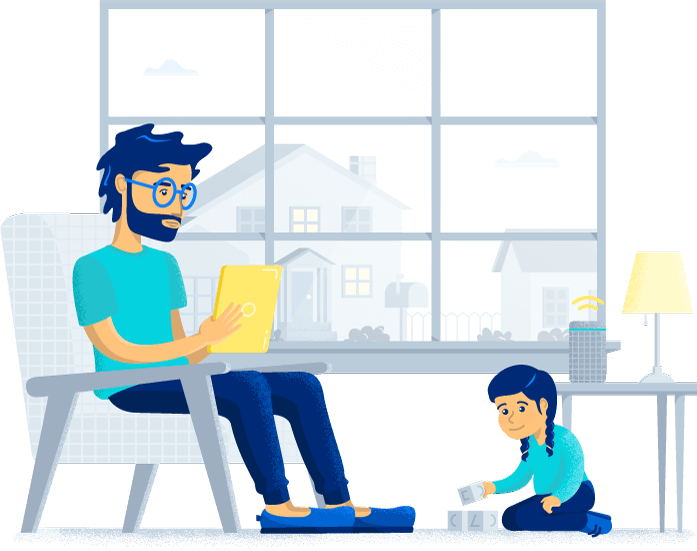[ad_1]
We know there’s tons of information out there when it comes to the internet, and sometimes it can get overwhelming for anyone, but especially older adults. We’ve compiled a guide that has everything you need to know about the internet in one place.
Internet basics
The internet can be confusing at times, so we’ll go over some internet basics below.
What is the internet and how does it work?
First things first, what is the internet? The internet is a global network linking all the computers and databases around the world. If this sounds confusing, just think of the internet as a cloud that contains all the content and information existing online, whether it’s social media, search engines, websites, etc. Basically, if you ever Google something, post on Facebook or even open your email, you’re using the internet.
You connect to the internet through devices like computers, phones, tablets and security cameras, to name a few. By using a device to connect to the internet, you can access the content existing in that world-wide cloud of content.
Wi-Fi
In order to access the internet through your personal devices that we mentioned above, you’ll need to set up a wireless network called Wi-Fi. Wi-Fi allows you to access the internet through multiple devices within your home, whether it’s a desktop computer, laptop, tablet, cell phone or TV.
Equipment
Internet equipment consists of a modem and a router at the most basic level. A modem establishes your home’s connection to the internet while a router is the device that allows your individual devices (phone, computer, tablet, etc.) to connect to the internet. When you sign up for internet service, the equipment will usually be available through your provider as part of your plan or to rent for a fee.
Now that you know a bit about internet basics, we’ll go over how to set up your internet connection.
Setting up your internet connection
Whether you’re deciding to get internet for the first time or are switching up service, we explain everything you need to do to set up your connection below.
1. Find out what providers are in your area
This is the first and most important step in the process. Before you set up internet, you need to find out what internet provider can provide service to your home. To do this, enter your address and we will list the providers available at your location.
This part is important because not every home can get internet service from every provider. Even if your neighbor has internet service from one provider, that may not offer service to your home.
2. Pick a provider and plan
Once you’ve entered your home address and find out which providers are available, you can narrow down which provider works best for you. Each internet provider offers different plans, prices and internet types.
This can get a bit confusing if you’re not sure what type of plan you need, so read our internet speed guide to find the right speed for your internet activities. The Federal Communications Commission’s (FCC) minimum recommended internet speed is 25 Mbps, for reference. Although, most of us need at least 100 Mbps nowadays, with everything we do being online like our medical patient portals, utility bills and entertainment.
Once you know what speed you need, you’re ready to pick an internet plan. Plans are categorized by their speeds, so you’ll see numbers like 100 Mbps, 200 Mbps, 300 Mbps, etc. The ‘Mbps’ stands for megabits per second – the higher the number, the faster your internet connection will be.
3. Installation
If you’re setting up your internet connection over the phone with a customer service representative, they will walk you through the installation process. Just tell them what plan you want and you can schedule an appointment for someone to come to your home and set up your equipment. This is an easy way to make sure your internet connection is set up correctly.
What do you need for Wi-Fi?
If you want to connect multiple devices to the internet wirelessly, you need Wi-Fi. Wi-Fi requires two pieces of equipment: a modem and a router (or a gateway device that acts as both). Most providers include the equipment you need in your plan or charge you an extra monthly fee to rent it while you have their service. While you can buy your own, we recommend just going with your provider’s equipment if you are unfamiliar with internet equipment.
4. Get online
Once your equipment is set up and service activated, you’re ready to get online! Now you can access the internet from your home from your personal devices.
How to use the internet
Now that you have an internet connection, what can you do on the internet? This is a big question with a lot of answers, but we’ll outline some common internet activities.
Banking and bill pay
Many utility providers offer online bill pay as a payment method. If you currently pay your bills through the mail but are interested in online payments, you can call your provider and create an online payment account or even set up automatic payments every month so you’ll never miss a payment.
Online banking is also popular to pay bills and manage your finances. If you’re interested in online banking, your bank can help you download its app and set up your online banking account. If your utility provider doesn’t offer online bill pay, your bank can often send payments on your behalf through the online system.
Communication
You can use the internet to stay connected to outside news and for endless communication methods. The majority of people now receive their news online instead of from traditional newspapers.
Social media and email are great ways for people to keep in touch with each other. Facebook in particular is one platform popular among older adults.
Online shopping
You can buy just about anything online, whether it’s groceries, clothes, electronics and more. It can be convenient and faster than going out in person, so keep websites like Amazon and Instacart in mind if you need something fast.
These are just a few things you can do online. For more information on how to use the internet, read our guide on internet basics for seniors.
How to protect yourself on the internet
Once you’re connected to the internet, it’s important to understand how to stay safe. You may come across malicious websites, emails or ads on the internet that can leave you vulnerable to hackers trying to steal your personal information. Below we’ll go over some tips to help you stay safe online.
Use a variety of passwords
The easiest way to keep your accounts secure is to use unique passwords for each of your personal accounts. This can prevent hackers from accessing all of your accounts if they crack one of your passwords. If you struggle to remember your passwords, there are password managers like 1Password to keep your passwords in order.
Download antivirus software
Staying safe online can be as easy as downloading antivirus software. Antivirus software is a great way to cover all your bases. It blocks viruses and has anti-phishing tools to prevent you from engaging with scam websites.
Update your system regularly
You should set your computer settings to automatically update your system. This will ensure that the latest security features are installed and running in your system. Hackers can take advantage if your system hasn’t been updated in a while because this impacts the security of your system.
Read our internet safety guide for more information on how to stay safe online.
Wrapping up
Getting started with internet can be overwhelming, but if you understand the basics of what you can do on the internet and how to set it up, you’ll be familiar with the internet in no time.
Enter your address to find providers available at your address to get started.

Written by:
Camryn SmithAssociate Writer
Camryn Smith is an Associate Writer with Allconnect.com. She specializes in writing about the broadband industry and helping consumers navigate complex internet service purchasing decisions…. Read more
Edited by:
Robin LaytonEditor, Broadband Content
[ad_2]

